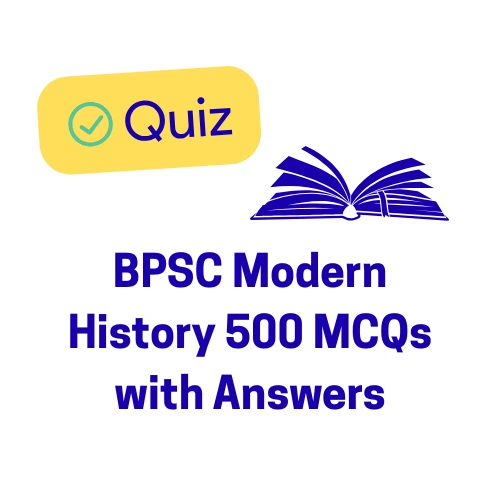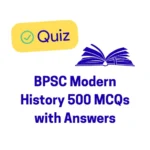BPSC Modern History Part 5 (500 MCQs) focus on the Reforms of Lord Dalhousie, the Revolt of 1857, and the Immediate Aftermath (Government of India Act, 1858).
BPSC Modern History Part 5 (500 MCQs)
Section K: Reforms of Lord Dalhousie (1848-1856)
Q121. Lord Dalhousie’s tenure (1848-1856) is known as the ‘Era of Annexation’ due to his implementation of which policy?
(A) Subsidiary Alliance System
(B) Ring Fence Policy
(C) Doctrine of Lapse
(D) Policy of Paramountcy
Q122. Which of the following states were annexed under the Doctrine of Lapse during Dalhousie’s administration?
Satara (1848)
Jhansi (1853)
Awadh (1856)
Sambalpur (1849)
(A) 1, 2, and 3 only
(B) 1, 2, and 4 only
(C) 2, 3, and 4 only
(D) 1, 2, 3, and 4
Q123. The first railway line in India, connecting Bombay to Thane, was opened in which year?
(A) 1848
(B) 1853
(C) 1854
(D) 1856
Q124. The Wood’s Despatch of 1854, a significant step in the history of education in India, recommended which of the following?
Establishment of Universities in Calcutta, Bombay, and Madras.
Establishment of a department of public instruction in each province.
Promotion of vernacular languages at the school level.
(A) 1 and 2 only
(B) 2 and 3 only
(C) 1 and 3 only
(D) 1, 2, and 3
Q125. Who is famously known as the ‘Father of Indian Telegraph’ due to his role in establishing the first telegraph line in India?
(A) Lord Dalhousie
(B) Sir Charles Wood
(C) Lord Canning
(D) Sir Henry Hardinge
BPSC Modern History Part 5 (500 MCQs)
Q126. The department of Public Works (PWD) was created and separated from the Military Board during the Governor-Generalship of:
(A) Lord William Bentinck
(B) Lord Auckland
(C) Lord Dalhousie
(D) Lord Canning
Q127. The first official postal stamp, known as ‘Scinde Dawk’, was introduced in which area during Dalhousie’s time?
(A) Bombay
(B) Calcutta
(C) Sindh
(D) Madras
Q128. Lord Dalhousie initiated the construction of the Ganges Canal. This was part of his reforms in which area?
(A) Military
(B) Judicial
(C) Engineering and Public Works
(D) Postal Services
Q129. The Charter Act of 1853, which separated the legislative and executive functions of the Governor-General’s Council, was enacted during the time of which Governor-General?
(A) Lord William Bentinck
(B) Lord Auckland
(C) Lord Dalhousie
(D) Lord Canning
Q130. The Hindu Widows’ Remarriage Act was officially passed in 1856. Who had played a crucial role as a reformer in lobbying for this act?
(A) Raja Ram Mohan Roy
(B) Keshub Chandra Sen
(C) Ishwar Chandra Vidyasagar
(D) Debendranath Tagore
Section L: The Revolt of 1857
Q131. Which of the following was/were the main political cause(s) for the Revolt of 1857?
Annexation of Awadh on the ground of misgovernance.
Application of the Doctrine of Lapse.
The Company’s refusal to recognize the titles of some Indian rulers after their death.
(A) 1 and 2 only
(B) 2 and 3 only
(C) 1 and 3 only
(D) 1, 2, and 3
Q132. The immediate cause for the Revolt of 1857 was:
(A) The introduction of the Doctrine of Lapse.
(B) The issue of the greased cartridges (Enfield Rifle).
(C) The annexation of Awadh.
(D) Economic exploitation of the peasants.
Q133. Mangal Pandey, the sepoy who first initiated the revolt, belonged to which native infantry?
(A) 24th Native Infantry
(B) 34th Native Infantry
(C) 47th Native Infantry
(D) 49th Native Infantry
Q134. Who was the Mughal Emperor proclaimed as the Emperor of India by the mutineers in Delhi?
(A) Bahadur Shah I
(B) Bahadur Shah Zafar (Bahadur Shah II)
(C) Shah Alam II
(D) Akbar Shah II
Q135. Which of the following pairs of leaders and their centers of revolt is incorrectly matched?
(A) Begum Hazrat Mahal: Lucknow
(B) Khan Bahadur Khan: Bareilly
(C) Kunwar Singh: Arrah, Bihar
(D) Lakshmi Bai: Kanpur
BPSC Modern History Part 5 (500 MCQs)
Q136. Who was the British officer who recaptured Delhi from the rebels in 1857?
(A) Colin Campbell
(B) John Nicholson
(C) Henry Lawrence
(D) Hugh Rose
Q137. Which famous Indian revolutionary leader was an able commander of Nana Saheb and was later captured and executed in 1859?
(A) Azimullah Khan
(B) Tatya Tope (Ramchandra Pandurang)
(C) Maulvi Ahmadullah Shah
(D) Kunwar Singh
Q138. The Revolt of 1857 was described as the ‘First War of Indian Independence’ by which historian/writer?
(A) S. N. Sen
(B) R. C. Majumdar
(C) V. D. Savarkar
(D) Karl Marx
Q139. Who was the British Governor-General of India during the Revolt of 1857?
(A) Lord Dalhousie
(B) Lord Canning
(C) Lord Elgin
(D) Lord Lawrence
Q140. Which region of India largely remained unaffected by the Revolt of 1857?
(A) Awadh and Rohilkhand
(B) Bihar and Eastern UP
(C) Bombay and Madras Presidencies
(D) Central India and Bundelkhand
BPSC Modern History Part 5 (500 MCQs)
Q141. The British officer who defeated and killed Rani Lakshmi Bai of Jhansi was:
(A) General Havelock
(B) Sir Hugh Rose
(C) General Neil
(D) General Outram
Q142. The revolt of 1857 was a struggle between civilization and barbarism, according to which British commentator?
(A) V. D. Savarkar
(B) T. R. Holmes
(C) R. C. Majumdar
(D) John Lawrence
Q143. Which two loyal Indian rulers helped the British to suppress the revolt, leading to a permanent shift in British policy regarding Princely States?
(A) Nizam of Hyderabad and Nawab of Awadh
(B) Scindia of Gwalior and Nizam of Hyderabad
(C) Holkar of Indore and Raja of Travancore
(D) Raja of Mysore and Gaekwad of Baroda
Section M: Aftermath of the Revolt (1858 Act)
Q144. The immediate consequence of the Revolt of 1857 was the enactment of which act?
(A) Charter Act of 1853
(B) Indian Councils Act, 1861
(C) Government of India Act, 1858
(D) Queen Victoria’s Proclamation, 1858
Q145. Which of the following was/were the feature(s) of the Government of India Act, 1858?
The rule of the East India Company was ended.
The post of Governor-General of India was replaced by the Viceroy of India.
A new office, Secretary of State for India, was created in England.
(A) 1 and 2 only
(B) 2 and 3 only
(C) 1 and 3 only
(D) 1, 2, and 3
Q146. Who was the first Viceroy of India, appointed under the Government of India Act, 1858?
(A) Lord Dalhousie
(B) Lord Canning
(C) Lord Lawrence
(D) Lord Lytton
Q147. Queen Victoria’s Proclamation, which ensured that the British Crown would honor the dignity and rights of the native princes, was read out at a Durbar held in which city?
(A) Calcutta
(B) Delhi
(C) Allahabad
(D) Lucknow
Q148. The ‘Sepoy Army’ was reorganized on the basis of the recommendations of which commission after the Revolt of 1857?
(A) Hunter Commission
(B) Sadler Commission
(C) Peel Commission
(D) Famine Commission
Q149. After 1858, the policy of the British towards Princely States was changed to:
(A) Complete annexation of all Princely States.
(B) Policy of Paramountcy and subordinate isolation.
(C) Policy of Subordinate Union (perpetual alliance and protection).
(D) Policy of non-interference and complete independence.
Q150. Which newspaper was noted for its sympathetic coverage of the Indian perspective during the Revolt of 1857?
(A) The Times of India
(B) The Hindu Patriot
(C) The Statesman
(D) Pioneer

